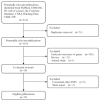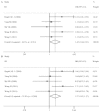Association between β2-Adrenergic Receptor-16Arg/Gly Gene Polymorphism and Chronic Obstructive Pulmonary Disease Risk:Systematic Review and Meta-Analysis
- PMID: 25909056
- PMCID: PMC4401053
Association between β2-Adrenergic Receptor-16Arg/Gly Gene Polymorphism and Chronic Obstructive Pulmonary Disease Risk:Systematic Review and Meta-Analysis
Abstract
Background: The association between β2-adrenergic receptor (ADRB2) -16Arg/Gly polymorphism (rs1042713) and chronic obstructive pulmonary disease (COPD) risk has been investigated in many published studies. However, the results were inconclusive. A meta-analysis was performed to make a more precise estimation of the relationship.
Methods: The PubMed, EMBASE, ISI web of science, the Cochrane Database of Systematic Reviews, and Chinese databases (CNKI, Wanfang Data, CBM, VIP) were searched for published literature. Odds ratios (OR) with 95% confidence interval (CI) were used to assess the strength of association.
Results: Eleven studies, comprising 1,128 COPD patients and 1,182 controls, were included in the meta-analysis. Overall, there was no significant association between the ADRB2-16Arg/Gly polymorphism and COPD risk in general population. In the stratification analysis by potential confounding variables, significant associations were observed between the ADRB2-16Arg/Gly polymorphism and COPD risk among smoking Asians under the dominant genetic model and allele model (Arg vs. Gly) (dominant model: OR = 1.45, 95% CI = 1.04-2.01, P = 0.311 for heterogeneity, z = 2.22, P = 0.026 for OR; allele model: OR = 1.27, 95% CI = 1.03-1.57, P = 0.209 for heterogeneity, z = 2.20, P = 0.028 for OR), but not in other subgroups.
Conclusion: This meta-analysis suggested that the ADRB2-16Arg/Gly polymorphism might be a potential risk factor for the development of COPD in smoking Asian populations, but not in European descendents, and tobacco smoking probably increased the genetic susceptibility. More studies with larger sample sizes are needed to validate the results.
Keywords: COPD; Meta-analysis; Tobacco smoking; rs1042713; β2-adrenergic receptor.
Figures





References
-
- Vestbo J, Hurd SS, Agusti AGet al. (2013). Global strategy for the diagnosis, management, and prevention of chronic obstructive pulmonary disease: GOLD executive summary. Am J Respir Crit Care Med, 187(4): 347–65. - PubMed
-
- Yamaya A, Osanai K (2011). [Cytokines and proteases involved in pathogenesis of COPD]. Nihon Rinsho Japanese Journal of Clinical Medicine, 69(10): 1748–53. - PubMed
-
- Sethi JM, Rochester CL (2000). Smoking and chronic obstructive pulmonary disease. Clin Chest Med, 21(1): 67–86. - PubMed
-
- Mannino DM, Homa DM, Akinbami LJ, Ford ES, Redd SC (2002). Chronic obstructive pulmonary disease surveillance—United States, 1971–2000. MMWR Surveill Summ, 51(6): 1–16. - PubMed
Publication types
LinkOut - more resources
Full Text Sources
Molecular Biology Databases
